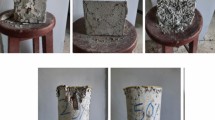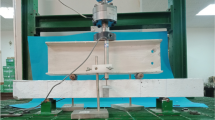Abstract
This study presents alternative shear strength prediction equations for reinforced concrete (RC) beams with stirrups. The shear strength is composed of the contribution of the nominal shear strength provided by stirrups and the nominal shear strength provided by concrete. For the concrete contribution, cracking shear strength values estimated by Arslan’s equations are almost same those obtained with ACI 318 simplified equation in terms of coefficient of variation (COV). However, mean values estimated by ACI 318 tend to be more conservative comparing to the mean values obtained with Arslan’s equations. Thus, for the consideration of concrete contribution to shear strength, Arslan’s equations are used. To obtain the shear strength of RC beams, shear strength provided by stirrups is added to the concrete shear strength estimated by Arslan’s equations. Results of existing 339 beam shear tests are used to investigate how accurate proposed equation estimates the shear strength of RC beams. Furthermore, ACI 318 and TS500 provisions are also compared to the aforementioned test results. It is found that proposed equations for beams with shear span to depth ratios (a/d) between 1.5 and 2.5 are also conservative with a lower COV than ACI 318 and TS500. However, when a/d ratios exceed 2.5 (both normal and high strength concrete beams), ACI 318, TS500 and proposed equations give similar COV value.
Similar content being viewed by others
References
ASCE-ACI 445 (1999) Recent approaches to shear design of structural concrete. State-of-the- Art-Report by ASCE-ACI Committee 445 on Shear and Torsion. ASCE J Struct Eng
Arslan G (2005) Shear strength of reinforced concrete frame members under cyclic loads. PhD thesis, Yıldız Technical University, Istanbul
Arslan G (2007) Cracking shear strength of RC slender beams without stirrups. Turkish Journal of Engineering & Environmental Sciences (in review)
Zsutty TC (1968) Beam shear strength prediction by analysis of existing data. ACI J 65(11):943–951
Bazant ZP, Kim JK (1984) Size effect in shear failure of longitudinally reinforced beams. ACI Struct J 81(5):456–468
CEB-FIP model code for concrete structures (1990) Comite Euro-International du Beton, Paris. CEB-FIP
JSCE (1991) Standard specification for design and construction of concrete structures, Part I (Design). Japan Soc. of Civil Engrs., Tokyo
ACI Committee 318 (2002) Building code for structural concrete (318R-2002) and commentary (318R-2002). American Concrete Institute, Farmington Hills, Michigan
Okamura H, Higai T (1980) Proposed design equation for shear strength of R.C. beams without web reinforcement. Proc Japan Soc Civil Eng 300:131–141
Ahmad SH, Khaloo AR, Poveda A (1986) Shear capacity of reinforced high-strength concrete beams. ACI J 83(2):297–305
Kim J-K, Park Y-D (1996) Prediction of shear strength of reinforced concrete beams without web reinforcement. ACI Mater J 93(3):213–222
Shin S-W, Lee K-S, Moon J, Ghosh, SK (1999) Shear strength of reinforced high-strength concrete beams with shear span-to-depth ratios between 1.5 and 2.5. ACI Struct J 96:549–556
Rebeiz KS (1999) Shear strength prediction for concrete members. J Struct Eng 125(3):301–308
ASCE-ACI 426 (1973) The shear strength of reinforced concrete members. Proc Am Soc Civil Eng 99(ST6):1091–1187
Bazant ZP, Yu Q (2003) Designing against size effect on shear strength of reinforced concrete beams without stirrups. ITI Report, submitted to ACI Committee 445, Shear and Torsion; version also submitted for publication in J Struct Eng
TS-500 requirements for design and construction of reinforced concrete structures, 2000. Turkish Standards Institute, Ankara (in Turkish)
Bresler B, Scordelis AC (1961) Shear strength of reinforced concrete beams. Series 100, Issue 13, Structures and Materials Research, Dept. of Civil Engineering. Univ. of California, Berkeley
Leonhardt F, Walter R (1962) Schubversuche an Einfeldriegen Stahlbeton-Balken mit und ohne Schubbewehrung zur Ermittlung der Schub tragfähigkeit und der Oberen Schubspannungsgrenze. Heft 151, Deutscher Ausschuss für Stahlbeton, W. Ernst u. Sohn, Berlin, 68 pp
Bresler B, Scordelis AC (1966) Shear strength of reinforced concrete beams – Series III. Report No. 65-10, Structures and Materials Research, Dept. of Civil Engineering, Univ. of California, Berkeley
Bahl NS (1968) Über den Einfluß der Balkenhöhe auf die Schubtragfähigkeit von Einfeldriegen Stahlbeton-Balken mit und ohne Schubbewehrung. PhD Dissertation, Universität Stuttgart, Germany, 125 pp
Placas A, Regan PE (1971) Shear failure of reinforced concrete beams. ACI J 68(10):763–773
Swamy RN, Andriopoulos AD (1974) Contribution of aggregate interlock and dowel forces to the shear resistance of reinforced beams with web Reinforcement. Shear in Reinforced Concrete, SP-42, ACI, Farmington Hills, Mich., pp 129–166
Mattock AH, Wang Z (1984) Shear strength of reinforced concrete members subject to high axial compressive stress. ACI Struct J 11(3):287–298
Mphonde AG, Frantz GC (1984) Shear tests of high- and low-strength concrete beams without stirrups. ACI J 81(4):350–357
Elzanaty AH, Nilson AH, Slate FO (1986) Shear capacity of reinforced concrete beams using high strength concrete. ACI J 65(1):290–296
Johnson MK, Ramirez JA (1989) Minimum shear reinforcement in beams with higher strength concrete. ACI Struct J 86(4):376–382
Anderson NS, Ramirez JA (1989) Detailing of stirrup reinforcement. ACI Struct J 86(5):507–515
Sarzam KF, Al-Musawi JMS (1992) Shear design of high- and normal-strength concrete beams with web reinforcement. ACI Struct J 89(6):658–664
Xie Y, Ahmad SH, Yu T, Hino S, Chung W (1994) Shear ductility of reinforced concrete beams of normal and high-strength concrete. ACI Struct J 91(2):140–149
McGormley JC, Creary DB, Ramirez JA (1996) The performance of epoxy-coated shear reinforcement. ACI Struct J 93(5):531–537
Yoon Y, Cook WD, Mitchell D (1996) Minimum shear reinforcement in normal-, medium-, and high-strength concrete beams. ACI Struct J 93(5): 576–584
Zararis PH, Papadakis G (1999) Influence of the arrangement of reinforcement on the shear strength of RC beams. Proceeding of the 13th Hellenic Conference on Concrete, Rethymnon, Greece, pp␣110–119
Karayiannis CG, Chalioris CE (1999) Experimental investigation of the influence of stirrups on the shear failure mechanism of reinforced concrete beams. Proceeding of the 13th Hellenic Conference on Concrete, Rethymnon, Greece, pp 133–141
Angelakos D, Bentz EC, Collins MP (2001) Effect of concrete strength and minimum stirrups on shear strength of large members. ACI Struct J 98(3):290–300
Gonzalez FB (2002) Hormigones con aridos reciclados procetendes de demoliciones: dosificaciones, propiedades mecanicas y comportamiento estructurea a cortante. Tesis doctoral dirigida por Prof. Fernando Martinez, ETSECCP de la Coruna, Universidad de la Coruna
Lyngberg BS (1976) Ultimate shear resistance of partially prestressed reinforced concrete I-beams. ACI J Proceedings 73(4)
Roller JJ, Russell HG (1990) Shear strength of high-strength concrete beams with web reinforcement. ACI Struct J 87(2):191–198
Kong PYL, Rangan BV (1998) Shear strength of high-performance concrete beams. ACI Struct J 95(6):677–688
Rahal KN, Al-Shaleh KS (2004) Minimum transverse reinforcement in 65 MPa concrete beams. ACI Struct J 101(6):872–878
Adebar P, Collins MP (1996) Shear strength of members without transverse reinforcement. Can J Civil Eng 23:30–41
Tan K, Kong F, Teng S, Weng L (1997) Effect of web reinforcement on high strength concrete deep beams. ACI J 94(5):572–582
Ozcebe G, Ersoy U, Tankut T (1999) Evaluation of minimum shear reinforcement requirements for higher strength concrete. ACI Struct J 96(3):361–368
Cladera A, Mari AR (2005) Experimental study on high-strength concrete beams failing in shear. Eng Struct 27:1519–1527
Etxeberria M, Mari AR, Vazquez E (2003) Estudio experimental de la resistencia a cortante en vigas de hormigon de aridos reciclados. PhD thesis, Universidad Politecnica da Cataluna
Collins MP, Kuchma D (1999) How safe are our large, lightly reinforced concrete beams, slabs and footings? ACI Structural Journal 96(4):482–490
Fenwick RC, Paulay T (1968) Mechanisms of shear resistance of concrete beams. J Struct Eng ASCE 94(10):2325–2350
Cho S-H (2003) Shear strength prediction by modified plasticity theory for short beams. ACI Struct J 100(1):105–112
Oh J-K, Shin S-W (2001) Shear strength of reinforced high-strength concrete deep beams. ACI Struct J␣98(2):164–173
Mathey RG, Watstein D (1963) Shear strength of beams without web reinforcement. ACI J 60(2):183–208
Taylor R (1960) Some shear tests on reinforced concrete beams without shear reinforcement. Mag Concrete Res 12(36):145–154
Kani GNJ (1966) Basic facts concerning shear failure. ACI J 63(6):675–692
Clark A (1951) Diagonal tension in reinforced concrete beams. ACI J Proceeding 48(2):145–156
Khuntia M, Stojadinovic B (2001) Shear strength of reinforced concrete beams without transverse reinforcement. ACI Struct J 98(5):648–656
Ersoy U, Özcebe G (2001) Betonarme. Evrim Yayınevi, Istanbul
Nilson AH, Winter G (1991) Design of concrete structures. Mc-Graw-Hill International Editions
Paulay T, Priestley MJN (1992) Seismic design of reinforced concrete and masonry. Wiley, New York
Carreira DJ, Chu K (1986) Stress-strain relationship for reinforced concrete in tension. ACI J 83(3):21–28
Massicotte B, Elwi AE, MacGregor JM (1990) Tension-stiffening model for planar reinforced concrete members. J Struct Eng ASCE 116(11):3039–3058
Author information
Authors and Affiliations
Corresponding author
Appendix—Estimation of concrete contribution to shear strength
Appendix—Estimation of concrete contribution to shear strength
In determination of concrete contribution to shear strength, cracking shear strength (v cr,t) and dowel actions (v cr,d) are considered [2, 3]. According to Khuntia and Stojadinovic [53], the shear stress distribution is modeled as parabolic over the effective shear depth with the maximum value at the neutral axis. Thus, the magnitude of shear resistance over the effective cross section equals τmax = f t = V cr,t /(2/3b w k 1 d), where b w is the width of section, τ max is the shear stress at the neutral axis, f t is the tensile strength of concrete, V cr,t is diagonal tension cracking shear force and k 1 d is the effective shear depth, respectively. The effective shear depth can be taken as k 1 d = kd(1 + ɛ cr /ɛ c ), where kd is the depth of neutral axis, ɛ c is the compressive strain in concrete and taken as 0.002. The cracking strain value in concrete is taken as \({\varepsilon _{cr} =f_t /E_c}\) , where E c is modulus of elasticity and equal to \({4750\sqrt {f_c}}\) in MPa [54]. The tensile strength of plain concrete f t , ranges from about 0.25 to 0.50 \({\sqrt {f_c}}\) [55–57]. The direct tensile strength is accepted as \({0.50\sqrt {f_c}}\) for normal strength concrete (NSC) and \({0.40\sqrt {f_c}}\) for high strength concrete (HSC). According to Kim and Park [11], k values can be expressed as follows, k = 0.82(nρ)0.36. Within the practical range, i.e., \({5\leq n\leq 10}\) and \({0.005\leq \rho \leq 0.035}\); consequently, \({0.025\leq n\rho \leq 0.35}\). During the formation of primary cracks, for a reinforcing ratio ρ less than a limiting value ρ stbl , the average strains increase until a stabilized cracking state is reached tension-softening stress in concrete at cracking. If ρ is the reinforcement ratio, and n = E s /E c is the modular ratio, the minimum reinforcement ratio required to maintain constant strain at the crack when the cracking load is applied to the member and held constant, is ρ stbl = 1/(6n) [58]. According to Massicotte et al. [58], this equation can also be interpreted as the minimum steel ratio needed for a test setup to measure accurately the tension-softening branch in a plain concrete tension test under a load-controlled procedure. Since ρ stbl is expressed by the minimum reinforcement ratio required to maintain constant strain at the crack, the corresponding limit value for the shear strength capacity of the diagonal tension crack of slender beams can also be interpreted as ρ stbl equal to ρ. Substituting these equations into \({v_{cr,t} =\frac{2}{3}f_t k_1}\), we obtain \({v_{cr,t} =0.15\sqrt {f_c}}\) (For NSC) and \({v_{cr,t} =0.12\sqrt {f_c}}\) (For HSC).
Substituting ρ stbl = 1/(6n) and n = E s /E c into \({V_{cr,d} =k_3 (f_c )^{0.5}\rho ^rb_w d}\) [11] and assuming that the modulus of elasticity of reinforcement is E s = 2.105 MPa and r = 0.3, the dowel strength can be expressed approximately by more general terms f c as follows v cr,d = 0.02(f c )0.65. The shear strength of a diagonal tension crack of slender beams may be expressed as Eq. (3).
Rights and permissions
About this article
Cite this article
Arslan, G. Shear strength of reinforced concrete beams with stirrups. Mater Struct 41, 113–122 (2008). https://doi.org/10.1617/s11527-007-9223-3
Received:
Accepted:
Published:
Issue Date:
DOI: https://doi.org/10.1617/s11527-007-9223-3




